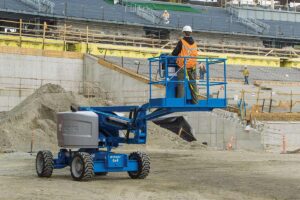Showing 81–96 of 195 results
-

Genie Z45/25
- Platform Height: 45 ft
- Lift Capacity: 500 lbs
- Power: Dual fuel (Gas/LPG) or Diesel


CanLift offers new and used Aerial Lifts for sale. Call us today at 1-877-338-5438 or contact us using the form below – operators are standing by to take your aerial platform order, and we ship worldwide!
Showing 81–96 of 195 results

Your privacy is very important to us. We do not sell, share, or distribute any of your personal information with any third parties. Please read our privacy policy for more information
CanLift Equipment offers a full selection of aerial lifts for sale from popular brands across Canada and North America. With operating heights ranging from 25 to 56 feet, rough terrain 4×4 aerial work platform models in both diesel and electric engines, CanLift has the selection of aerial platforms you need to get the perfect aerial lift for each job.
See our selection of aerial lifts for sale and lease.
Our expansive network of partner companies that span North America allows us to provide clients with a wide selection of aerial work platform equipment at the lowest prices possible.
Choose CanLift as your aerial platform provider, and you’re getting on-site and responsive personalized service. Since CanLift’s focus is 100% customer satisfaction, our goal is building long-lasting relationships with each and every client, so that you know you can trust in our aerial work platforms along with all of the equipment we offer.

Contact our sales and rental team today for a free, no-obligation quote on aerial lift equipment.
Aerial lifts, also known as cherry pickers or boom lifts, are versatile machines designed to elevate workers and their tools to access hard to reach areas safely. Aerial lifts consist of a platform, hence often being called aerial platforms, or bucket attached to an extendable arm or boom, which can be raised or lowered, and often rotated. They find widespread use in various industries and applications due to their ability to provide safe and efficient access to elevated workspaces. One common application of aerial lifts is in construction and glazing. Workers use aerial lift equipment to reach heights that would be challenging or unsafe using traditional ladders or even scaffolding. Aerial lifts are especially valuable for tasks such as installing or repairing electrical wiring, painting high structures, or working on the exterior of buildings. In maintenance and repair work, aerial lifts play a crucial role. Whether it's fixing streetlights, maintaining signage, hanging decorations, or trimming trees, aerial lift equipment offers a stable and secure platform for workers to perform tasks at different heights safely. Emergency services, such as firefighters and rescue teams, also use aerial lifts to access elevated locations during emergencies or rescue operations. This enables them to reach people trapped at heights and tackle incidents in high-rise buildings more effectively with added safety. Industries like telecommunications use aerial lifts for installing, maintaining, or repairing equipment on cell towers and utility poles. This application of an aerial lift is vital for ensuring the reliability of communication networks. Aerial lifts serve as essential tools in various fields to a number of industries, providing a safe and efficient means of reaching elevated workspaces for tasks ranging from construction and maintenance to emergency response and telecommunications.
The maximum lift capacity of aerial lifts depends on the type and model. Generally, smaller scissor lifts may have a capacity of around 500 to 1,000 pounds, while larger boom lifts can handle several thousand pounds. It's important to note that exceeding the specified weight limit of an aerial lift can compromise the stability and safety of the lift. The lift capacity of aerial lifts also depends on factors such as the structural integrity of the lift, the length and design of the boom, and the stability of the base. Going beyond the rated capacity of the aerial lift can lead to overloading, causing the lift to tip over or the structural components to fail, posing a serious safety risk. Manufacturers carefully engineer and test aerial lifts to ensure they can safely support the specified weight under various conditions. Compliance with these weight limits is critical to preventing accidents and ensures the well-being of workers who rely on these lifts to perform tasks at elevated heights. It's imperative for operators and users to be aware of and adhere to the aerial lift's rated capacity to maintain a safe working environment.
Yes, training is certainly required to operate an aerial lift. Operating an aerial lift involves specific skills and knowledge to ensure the safety of the operator, other workers, and the overall workplace. Regulatory bodies mandate that operators receive proper training and certification before using aerial lifts, even though many of the lifts we carry are quite intuitive. The primary reason for mandatory training is to prevent accidents and injuries associated with the operation of aerial platform machines. Aerial lifts can be complex, with features like extendable booms, rotating platforms, and variable height adjustments. Improper operation or lack of understanding of these features can lead to accidents such as tip-overs, collisions, or even dangerous falls from great heights. Training programs cover crucial aspects, including equipment inspections, proper use of controls, understanding weight limits, and recognizing potential hazards. Additionally, operators learn about the importance of maintaining stability, using fall protection equipment, and properly enforced emergency procedures. By ensuring that operators are well-trained, employers can reduce the risk of accidents, enhance workplace safety, and comply with legal regulations. Proper training not only safeguards the well-being of operators but also contributes to the overall efficiency and productivity of many tasks performed using aerial lifts. It is essential for individuals operating aerial lifts to undergo comprehensive training to acquire the necessary skills and knowledge for safe and effective aerial lift operations.
No, scissor lifts typically do not reach higher than aerial lifts. Aerial lifts, especially boom lifts, have a more flexible design with an extendable arm or boom that allows them to reach higher elevations compared to that of scissor lifts. Scissor lifts, on the other hand, move in a vertical direction only, lifting the platform straight up and down. Aerial lifts (including boom lifts and cherry pickers) can extend their arms both horizontally and vertically, providing greater reach and flexibility. This makes them suitable for tasks that require access to higher and more challenging areas, like in construction, glazing, maintenance, or tree trimming. Scissor lifts are typically used for tasks at lower heights where vertical movement is sufficient. They have a simpler mechanism, consisting of linked supports that extend and retract like a scissor, allowing for smooth vertical movement. While scissor lifts are sturdy and stable, they are more limited in terms of reach compared to the versatile design of aerial lifts. These are often used in warehouses.
Aerial lifts come in many different types, each serving specific purposes. Scissor lifts have a platform that moves straight up and down, making them handy for tasks at moderate heights, like fixing things on a single level. Boom lifts, with their extendable arms, have the ability to reach up and around obstacles, making them perfect for accessing higher and trickier spots, such as maintenance on tall buildings or when trimming trees. Articulating boom lifts are like boom lifts but have joints in the arm, offering extra flexibility for precise positioning in complex areas in difficult terrain. Telescopic boom lifts have straight arms that extend telescopically, providing both horizontal and vertical reach, making them great for tasks needing a mix of height and outreach, like construction projects and glazing. Vertical mast lifts are compact and move vertically, fitting well in tight spaces or for indoor maintenance jobs. Aerial ladder trucks are equipped with extendable ladders and are often used by firefighters and rescue teams for emergency response and reaching heights during firefighting or rescue operations. Each type of aerial lift plays a crucial role in different industries for varying tasks, ensuring safe and efficient access to elevated workspaces based on the specific needs of the task at hand.
No, aerial lifts and boom lifts are not one in the same. Aerial lifts are a broader category that includes various types of lifting equipment, while boom lifts are a specific type of aerial lift. Aerial lifts encompass a range of machines designed to lift workers and equipment to elevated areas in multiple modalities, including scissor lifts, vertical mast lifts, and boom lifts. On the other hand, a boom lift refers specifically to lifts with an extendable arm or boom that allows for both vertical and horizontal movement. All boom lifts are aerial lifts, but not all aerial lifts are boom lifts. Aerial lifts may have different mechanisms, including scissor-style lifting or vertical masts, but it depends on the type of lift. Understanding this difference is essential for choosing the right equipment for specific tasks, as the design and capabilities of boom lifts make them particularly suitable for certain jobs that require extended outreach and flexibility in reaching heights and angles.